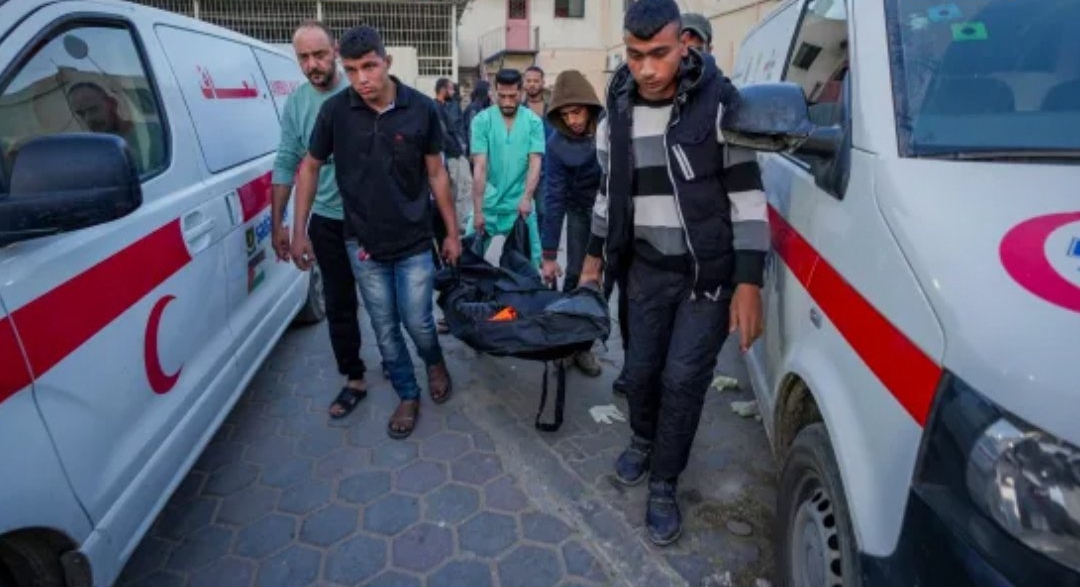By Adeyemi Adekunle
Israeli air strikes across the Gaza Strip claimed at least 52 lives, including the chief of Gaza’s police force, Mahmud Salah, and his deputy, Hussam Shahwan. Among the victims were children and families seeking refuge in what was supposed to be a “humanitarian zone” in al-Mawasi, near Khan Younis. The strikes have further deepened the region’s agony, drawing widespread condemnation and raising urgent questions about civilian safety.
The deadliest strike targeted a tent in the coastal area of al-Mawasi, killing 12 people, many of them children, as they sheltered from the ongoing conflict.
Medical sources reported the aftermath as catastrophic, with survivors scrambling to locate loved ones amidst charred remains and debris. A video from the scene showed frantic searches for survivors, with flames consuming makeshift shelters and scattered belongings—a haunting reminder of the human toll.
Gaza’s Interior Ministry decried the deaths of Salah and Shahwan, emphasizing their dedication to serving the people amid the chaos. “The police force is a civil protection unit, not a combat force.
Their only mission was to help our citizens,” the ministry stated. Israel, however, claimed the attack was intelligence-based and described Shahwan as a senior member of Hamas’s security apparatus, without addressing Salah’s death.
Al-Mawasi, a region that families had once trusted as a safer refuge, has been relentlessly bombarded. No warnings were issued ahead of Thursday’s predawn strike, which marked an escalation in the ongoing violence. Survivors, already displaced by earlier attacks, now face the impossible task of finding shelter in a conflict zone where no place seems secure.
The lack of advance notice has drawn sharp criticism from human rights groups and local authorities, who argue that the principle of protecting civilians is being flagrantly violated.
This strike comes amid a series of deadly attacks across Gaza. Elsewhere in the territory, nine people were killed in a gas station explosion on the outskirts of Deir el-Balah, their remains described by witnesses as “shredded” by the sheer force of the blast.
Another strike at Jabalia refugee camp claimed at least seven lives, while smaller attacks targeted Bani Suheila and Shati camp, adding to the growing death toll.
Al Jazeera’s Tareq Abu Azzoum, reporting from the heart of the devastation, described scenes of mourning mothers cradling lifeless bodies, their grief a testament to the unbearable cost of the violence.
Israeli forces have repeatedly emphasized that their strikes are aimed at disrupting Hamas operations. Yet, for many in Gaza, these actions have blurred the lines between combatants and civilians.
Entire families have been wiped out, and designated “safe zones” like schools and humanitarian areas have become targets. Displaced residents, already facing freezing conditions and dwindling resources, are left to grapple with the impossibility of survival in a war zone.
Al-Mawasi has been under relentless pressure in recent weeks, with Israeli tanks advancing from Rafah and forcing families to flee northward.
Residents of targeted areas in northern Gaza, including Jabalia refugee camp, were warned to evacuate, a tactic that some critics label psychological warfare. As one military spokesperson described it, these warnings serve as “pre-anaesthesia before the attack,” offering no genuine refuge to those who comply.
The strikes also follow a tragic December marked by repeated attacks. Earlier last month, an air raid killed eight people, including two children, in the same area.
Another strike on December 3 left 20 dead, with Israel justifying the attack as targeting a Hamas official. The cumulative toll has left Gaza’s infrastructure and medical systems stretched beyond capacity, with hospitals struggling to manage the influx of casualties.
As the death count rises, calls for accountability and a halt to the violence grow louder. International observers have highlighted the devastating impact on civilians, with children paying the heaviest price.
Reports of hypothermia-related deaths in Gaza’s harsh winter have compounded the tragedy, underlining the humanitarian catastrophe unfolding in the Strip.
The escalating violence has once again spotlighted the fragile and volatile nature of life in Gaza, where each day brings fresh uncertainty and heartbreak. For families mourning the loss of loved ones, the promise of peace feels further away than ever.




